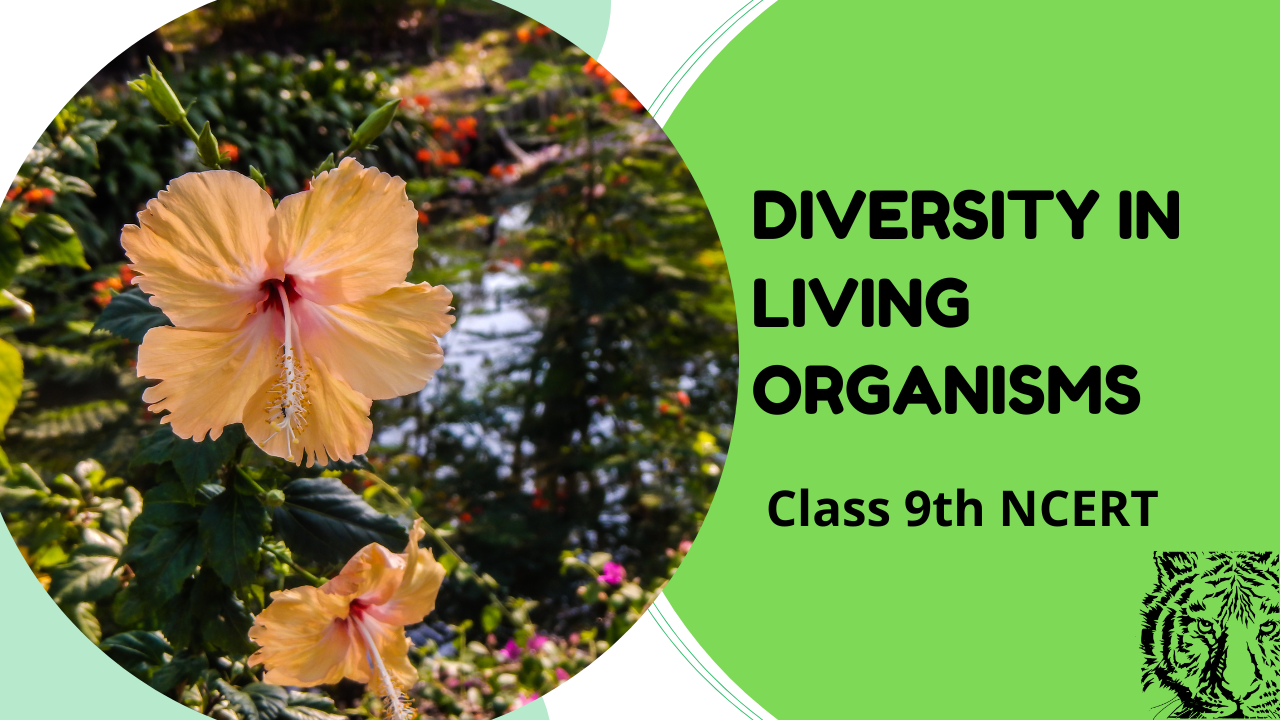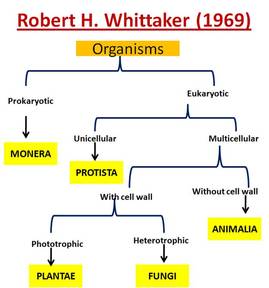We have shared Diversity In Living Organisms Class 9th notes to help the students of class 9th to be able to grasp the topic and be able to attempt the questions very easily. We have also shared NCERT Solutions For Class 9th Diversity In Living Organisms to help the students with the NCERT Questions.
We have also shared some important diagrams and classifications along with a table of flora and fauna with their scientific names. Diversity In Living Organisms Class 9th is a very important and detailed chapter of Science Biology and we have shared each and every possible detail of it.
Students can take a quick revision and get the gist of the chapter. In this lesson, we are going to study the diverse organisms on the earth and why and how they are diverse.
Diversity In Living Organisms Class 9th: Introduction
Diversity
This earth is full of organisms of various shapes and sizes. The largest Phylum of the animal kingdom alone contains over a million species. There are varieties of plants, right from small grasses too tall Eucalyptus trees. This variety in living beings is called diversity.
Biodiversity
The variety of animals and plants living in a given geographical area is called the biodiversity of that geographical area.
Need for a System of Classification
Because of the huge diversity in living beings, it becomes a very difficult task to study each of them one by one. To make their study easier animals and plants were categorized into groups and subgroups. Thus the system of classification started.
Classification by Aristotle
Aristotle classified animals according to their living environment. So he categorized them as either aquatic or terrestrial.
Drawbacks of Aristotle’s Classification
Aristotle‘s classification was not a good one as it categorized only aquatic and terrestrial animals.
Basis of Classification
Presence or Absence of Nucleus in Cells
Prokaryotes- Those organisms which have cells without a well-defined nucleus are called prokaryotes.
Eukaryotes-Those organisms that have cells with well-defined nuclei are Called eukaryotes. The presence of nucleus and membrane-bound organelles gives better efficiency to cells.
Number of Cells in an Organism
Unicellular-Those organisms having single cells are termed unicellular organisms. A single cell is responsible for all the necessary reactions of life.
Multicellular- Those organisms having more than one cell are called multicellular organisms. There is a division of labor to divide the functions of all the cells.
Mode of Nutrition
Autotrophs- Those organisms which are capable of producing their own food through a process of photosynthesis. All green plants are capable of synthesizing their own food and hence are called autotrophs. They have the pigment in their leaves is called chlorophyll which helps in this food-making process.
Heterotrophs- Those organisms which are dependent on either plants or animals for their food are the heterotrophs. They lack chlorophyll and are dependent on others for their food. Animals including fungi, certain bacteria, and protozoa belong to this group.
Level of Organisation in Body
In multicellular organisms like a hydra, a particular group of cells perform the necessary functions but in the case of humans, it is completely different as different functions have different organ systems to perform.
Evolutionary Relationship or Phylogenetic Relationship
Charles Darwin wrote the book “Origin of Species’ in 1859 and gave his theories of evolution. As per his theories, all organisms have evolved from unicellular organisms. Primitive body designs came early in evolutionary history leading to more complex designs. This gave rise to such a huge diversity in life forms.
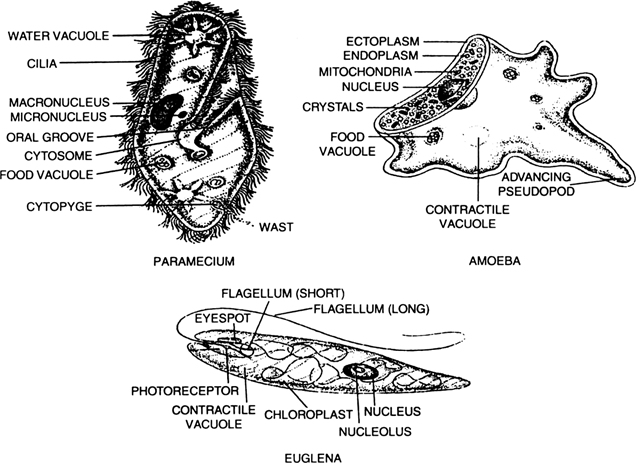
Diversity In Living Organisms Class 9th: The Hierarchy of Classification—Groups
Biologists, such as Ernst Haeckel (1894), Robert Whittaker (1959), and Carl Woese (1977) have tried to classify all living organisms into broad categories, called kingdoms.
Whittaker’s Five Kingdom Classification
Monera
Protista
Fungi
Plantae
Animalia.
Further Levels of Classification Beyond Kingdom
Phylum (for animals)/Division (for plants)
Class
Order
Family
Genus
Species
Thus, by separating organisms on the basis of a hierarchy of characteristics into smaller and smaller groups, we arrive at the basic unit of classification, which is a ‘species’. Broadly, a species includes all organisms that are similar enough to breed and perpetuate.
Monera
These organisms do not have a defined nucleus or organelles and are unicellular.
Cell walls are present in some organisms of this group.
Nutrition: Autotrophic or heterotrophic
Examples: Bacteria and blue-green algae
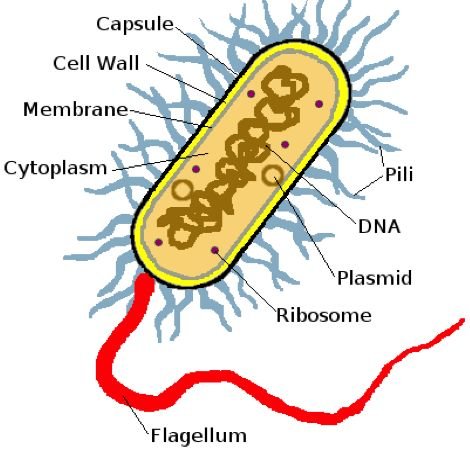
Protista
Unicellular eukaryotic organisms.
Locomotion: By Hair-like cilia or whip-like flagella for moving around in some members.
Nutrition: Autotrophic or heterotrophic.
Examples: Algae, protozoans {Plasmodium, Entamoeba)
Fungi
Heterotrophic eukaryotic organisms.
Nutrition: Saprophytic use decaying organic materials as food.
Lichens: Some fungi live in a symbiotic relationship with cyanobacteria. They are called lichens. The algal part provides food and the fungal part provides minerals and substratum.
Plantae
Multicellular eukaryotes with cell walls.
Nutrition: Autotrophs use chlorophyll for photosynthesis.
Animalia
Multicellular eukaryotes without cell walls.
Nutrition Heterotrophs.
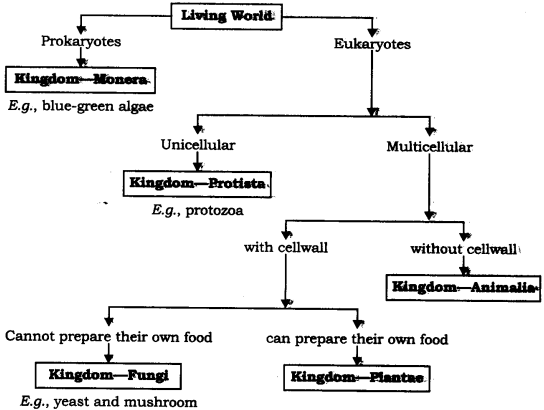
Thallophyta or Algae: Plants that do not have well-differentiated body design fall in this group. The plants in this group are commonly called algae. These plants are predominantly aquatic. Examples are Spirogyra, Ulothrix, Cladophora, and Chora.
Bryophyta: These are called the amphibians of the plant kingdom. The plant body is commonly differentiated to form stem and leaf-like structures. However, there is no specialized tissue for the conduction of water and other substances from one part of the plant body to another. Examples are moss (Funaria) and Marchantia.
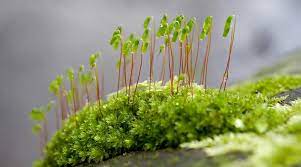
Pteridophyta: The plant body is differentiated into roots, stems, and leaves and has specialized tissue for the conduction of water and other substances from one part of the plant body to another. Some examples are MarsUea, ferns, and horsetails.
Gymnosperms: The plants of this group bear naked seeds and are usually perennial, evergreen and woody. Examples are pines and deodar.
Angiosperms: This word is made from two Greek words: angio means covered and Sperma—means seed. The seeds develop inside an organ which is modified to become a fruit. These are also called flowering plants. Plant embryos in seeds have structures called cotyledons.
Cotyledons: Cotyledons are called ‘seed leaves’ because in many instances they emerge and become green when the seed germinates.
The angiosperms are divided into two groups on the basis of the number of cotyledons present in the seed.
- Monocotyledonous: Seeds have a single cotyledon.
- Dicotyledonous: Seeds have two cotyledons.
Classification of Kingdom Animalia: Kingdom Animalia is further classified into several following phyla. Each phylum has its own classes, sub-classes orders, families, etc.
- Porifera
- These are non-motile animals attached to some solid support which comprises spicules of calcium carbonate and silica.
- There are holes or “pores’, all over the body. These lead to a canal system that helps in circulating water throughout the body to bring in food and oxygen.
- Animals are covered with a hard outside layer or skeleton which comprises spicules of calcium carbonate, and silica.
- They have very minimal differentiation and division into tissues.
- Examples: Sponges
- Coelenterata
- Aquatic animals.
- There is a cavity in the body hence the name Coelenterate (coelom means cavity).
- The body is made of two layers of cells.
- Examples: Hydra, Jellyfish
- Platyhelminthes
- The body is bilaterally symmetrical, meaning that the left and the right halves of the body have the same design.
- There are three layers of cells from which differentiated tissues can be made, which is why such animals are called triploblastic.
- There is no true internal body cavity or coelom, in which well developed
organs can be accommodated. - The body is flattened dorsoventrally, meaning from top to bottom, which is why these animals are called flatworms.
- They are either free-living or parasitic.
- Examples: Planaria, Liver fluke
- Nematoda
- The body is bilaterally symmetrical and triploblastic.
- The body is cylindrical rather than flattened.
- False body cavity or a pseudocolor, is present.
- These are very familiar as parasitic worms causing diseases, such as the worms causing elephantiasis (filarial worms) or the worms in the intestines (roundworm or pinworms).
- Examples: Ascaris, Wuchereria
- Annelida
- These are bilaterally symmetrical and triploblastic.
- True body cavity present.
- The body is divided into many ring-like segments, hence the name Annelida.
- Examples: Earthworms, Leech
- Arthropoda
- The largest group of animals.
- These are bilaterally symmetrical and segmented.
- There is an open circulatory system, and so the blood does not flow in well-defined blood vessels.
- They have jointed legs (the word ‘arthropod’ means jointed legs’).
- Examples: Ants, Cockroach, Grasshopper, Scorpions
- Mollusca
- These are bilaterally symmetrical.
- Reduced coelomic cavity.
- The soft body is covered with a hard shell made of calcium carbonate.
- Examples: Snails, Mussels.
- Echinodermata
- In Greek, echino means hedgehog, and derma means skin. Thus, these are spiny-skinned organisms.
- Exclusively free-living marine animals.
- Triploblastic animals with coelom.
- They have a peculiar water-driven tube system that they use for moving around.
- Skeleton made of calcium carbonate.
- Examples: Starfish and Sea urchins
- Protochordate
- These animals are bilaterally symmetrical, triploblastic, and have a coelom.
- In addition, they show a new feature of body design, namely a notochord, at least at some stages during their lives.
- The notochord is a long rod-like support structure (chord*string) that runs along the back of the animal separating the nervous tissue from the gut. It provides a place for muscles to attach for ease of movement.
Examples: Balanoglossus, Herdemarda, and Amphioxus.
- Vertebrata
These animals have a true vertebral column and internal skeleton, allowing a completely different distribution of muscle attachment points to be used for movement. Vertebrates are bilaterally symmetrical, triploblastic, coelomic, and segmented, with complex differentiation of body tissues and organs. All chordates possess the following features:- Notochord
- Dorsal nerve cord
- Triploblastic
- Paired gill pouches
- Coelomate
Diversity In Living Organisms Class 9th Science: Vertebrates are grouped into five classes
- Pisces
- The body is streamlined and has fins and a tail for swimming.
- Skin is covered with scales.
- Skeletons can be made of bone or cartilage.
- Intake of oxygen is by gills.
- Cold-blooded animals.
- The two-chambered heart is present.
- Examples: Fishes like Rohu, Tuna, Shark
- Amphibia
- They are adapted to live both on land and water.
- Respiration is through either gills or lungs.
- The three-chambered heart is present.
- Examples: Frogs, Toads, Salamander
- Reptilia
- These are crawling animals.
- Skin is rough and modified to withstand extreme temperatures.
- The heart is three-chambered in most, while four-chambered in crocodiles.
- Cold-blooded animals.
- Examples: Lizards, Turtles, Snakes
- Aves
- The body is covered with feathers and the forelimbs are modified for flying.
- Breathing through lungs.
- Warms-blooded animals.
- The four-chambered heart is present.
- Examples: Sparrow, Eagle, Crow, Parrot
- Mammalia
- Mammary glands are present which produce milk to nurture young ones.
- Skin is covered with hairs and has sweat glands and sebaceous glands.
- Warm-blooded animals with four-chambered hearts.
- Most animals are viviparous (giving birth to live young ones), and some are oviparous (producing eggs).
- Examples: Man, Horse, Kangaroo, Lion
Conventions for writing the scientific names
- The name of the genus begins with a capital letter.
- The name of the species begins with a small letter.
- When printed, the scientific name is given in italics.
- When written by hand, the genus name and the species name have to be underlined separately.
NCERT Solutions For Class 9th Science Diversity In Living Organisms
Q1. Why do we classify organisms?
For an easier and more convenient study, we classify organisms.
Q2. Give three examples of the range of variations that you see in life forms around you.
- Small cat and big cow
- Grass and banyan tree
- Black crow and green parrot
Q3. Which do you think is a more- basic characteristic for classifying organisms?
(a) the place where they live.
(b) the kind of cells they are made of. Why?
Classification based on living place is more basic as there can be wide variations in organisms living in a given place.
Q4. What is the primary characteristic on which the first division of organisms is made?
The nature of the cell is based on the division of organisms and hence life forms can be categorized into prokaryotes and eukaryotes.
Q5. On what bases are plants and animals out into different categories?
Mode of nutrition and presence or absence of cell walls.
Q6. Which organisms are called primitive and how are they different from the so-called – advanced organisms?
Organisms with simple cellular structures and no division of labor are called primitive. Advanced organisms, like mammals, have millions of cells and there are different organs and organ systems for different biological functions.
Q7. Will admits need organisms be the same as complex organisms? Why? T
Yes, advanced organisms mean a greater degree of evolution which leads to more complexity.
Q8. What is the criterion for the classification of organisms as belonging to the kingdom Monera or Protista?
It is the presence or absence of a well-defined nucleus. Monera has no nuclear membrane, while Protista shows a well-defined nucleus.
Q9. In which kingdom will you place an organism which is single-celled, eukaryotic, and photosynthetic?
Protista.
Q10. In the hierarchy of classification, which grouping will have the smallest number of organisms with a maximum of characteristics in common, and which will have the largest number of organisms?
Organisms belonging to Kingdom Monera will have a small number of organisms with a maximum of characteristics in common. And kingdom Animalia will have the largest number of organisms.
Q11. Which division among plants has the simplest organisms?
Thallophyta or algae.
Q12. How are pteridophytes different from the phanerogams?
Pteridophytes have naked embryos and reproductive organs whereas — phanerogams have well-differentiated reproductive organs and covered embryos.
Q13. How do gymnosperms and angiosperms differ from each other?
Seeds are naked in Gymnosperms and are covered in angiosperms.
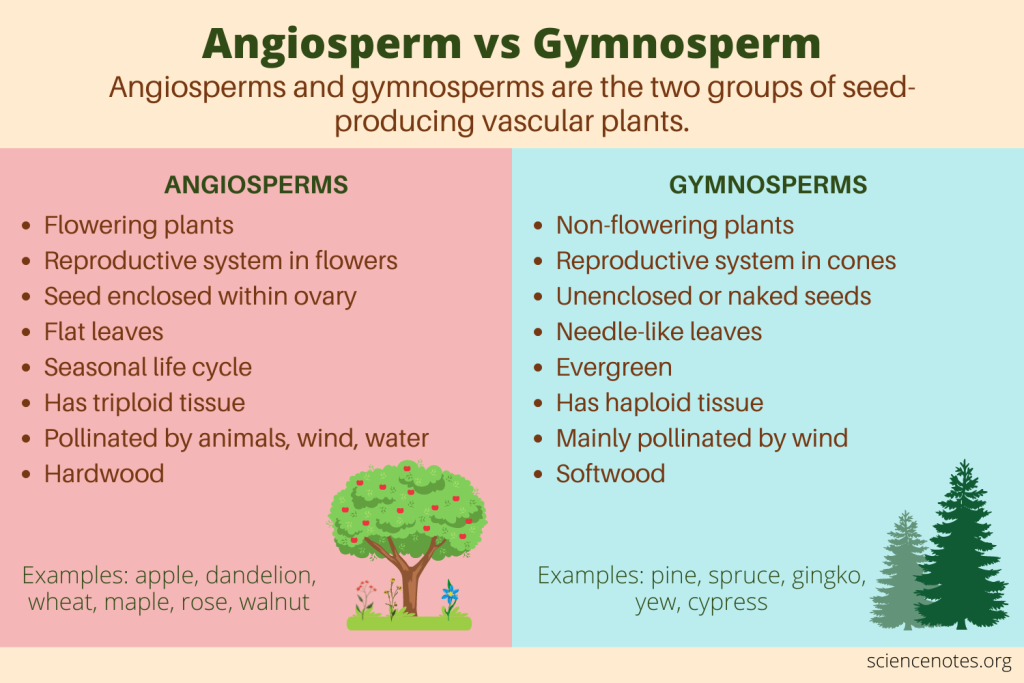
Q14. How do poriferan animals differ from coelenterate animals?
- Animals from Porifera show the cellular level of organization, while those from Coelenterata show the tissue level of organization.
- In Porifera, there is no division of labor, while in Coelenterata some division of labor is seen.
- Porifera do not have a coelom, while coelenterates have a coelom.
Conclusion
We have provided you with the short and detailed short notes on Diversity in living organisms Class 9th along with the NCERT Solutions For Class 9th Diversity In Living Organisms for the students to go through before their examinations. Students would be able to get the gist of the lesson and be able to attempt the questions in the examination.
Related Articles

